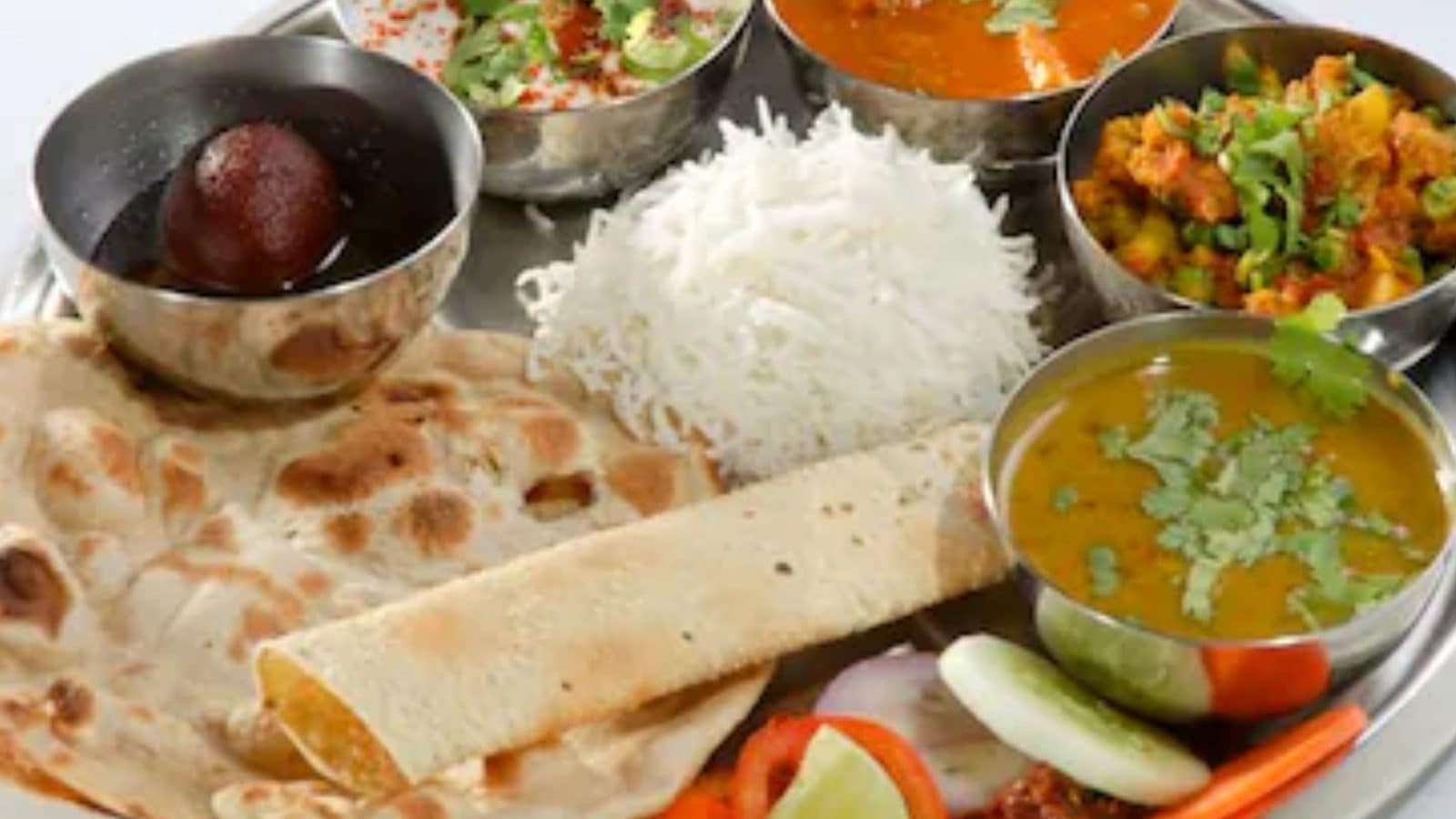What the Fork: Thali is Happiness, Rich Flavours on a Platter, Writes Kunal Vijaykar

It’s the one thing I miss in this brisk, bustling and busy world of ours. We have stopped eating in thalis at home. It’s either a smaller stainless-steel dish, ceramic crockery, or at its most repulsive, melamine. I hanker for a full thali of glistening steel and yearn for half a dozen katoris hemming the rim of the thali, all waiting to be filled with a diversity of dishes. In truth enjoying the anticipation, more than the variety of food.
At the risk of sounding patrician and dandled, I hate food being arranged in bowls in front of me, from which I have to help myself and I sorely miss being served like we did when young, sitting at a large 12-seater table at my grandmother’s house, while the cook served us one by one.
To be able to sit at a table, with a large round thali festooned with katoris and being served unlimited hot food, chapatis and rice is my idea of paradise. I can now find this in what are known as thali restaurants all over the country.
Most Indian states have their own version of the thali, although it is said that thali originated in South India. A thali is a complete meal, made up of about 10 or more dishes. A well-balanced thali will always have a grain or millet (rice or chapati or bhakri or puri), lentils (dal, varan, rasam or sambar), pulses (moong, vaal, masoor, chick-pea, matki), two or more vegetables based on what is in season, some sort of chutney, made with fruit, raw vegetable, herbs, spices. Curd in some form possibly mixed with some kind of vegetable or fruit like a raita. And pickle. Basically, it is a harmonious meal that includes carbs, protein, vitamins, minerals, and fibre.
My favourite two thalis are the Dakshin Kannada Udipi Thali from Karnataka and the Gujarati Thali. Both these thalis are vegetarian. In the centre of any South Indian Thali is rice, and is surrounded with dishes, that are meant to be consumed by mixing them with rice. A classic Konkani Karnataka Thali could consist of an array of mildly spicy, simply cooked vegetarian fare. Like green moong usli – green mung beans cooked lightly spices garnished with coconut. Cabbage or raw banana upkari – finely shredded cabbage or raw banana cooked dry with just a few spices. Kadale kalu usli – chickpeas cooked in spices in a thin gravy. Rasam, pigeon pea lentil or toor dal cooked with a fiery spice mix. Fritters made of vegetables and fruits.
Although I am such a carnivore and a worshipper of meat, the Gujarati thali for me is quite an allure. This is one of the most elaborate thalis. It includes several fried snacks, breads, a variety of vegetables, either in gravy, stir-fried or dry, all cooked in ghee, and a variety of savouries and sweets.
Besides the cuisine itself, it’s the beguiling wait of being served spicy, sweet, salty, bitter, sour and astringent tastes on one single plate that evokes emotion. The anticipation of eating something fried and steamed, as well as roasted and baked, braised or stewed in one single meal is overwhelming. It’s the limitlessness of the meal. It’s the idea that this is how any Indian meal should be served. The way it was served by our grandparents and their parents before them. Be it from any region.
Mumbai has its own list of traditional thali favourites, especially in the Kalbadevi, Pydhonie area of South Mumbai. But what I miss is the simple kadhi, daal, two sabzis, chapati, bhakri, khichdi and just one or two farsaan on a thali. Status at Nariman Point and Thackers at Chowpatty somewhat fit the bill. I find that these two thalis have a bit of modesty and restraint. It’s like eating at friend’s home. But if you’re looking for flamboyance and indulgence, then it’s Shree Thakker Bhojnalay in the congested and historical Fanas Wadi area. The meal starts with unlimited glasses of buttermilk and a variety of farsaan and starters. Dhoklas in all colours, bhajiyas made of anything from potato to methi to large green chillies. Chutneys of the sweet, spicy and sour kind. Kachumbar, rotlis and rotlas, bhakris and bhakras, puris and puran polis, all doused in melted ghee. Then a variety of freshly cooked veggies and pulses. Doodhi, tendli, chavli, moong to name a few. All served with sweet dal, kadhi, lachko daal rice, pulao khichdi, papad, and pickle and with two kinds of sweet dishes.
I discovered one more thali joint this week. It’s called Green Gujarat at Lower Parel and boasts of authentic (sic) Gujarati and Marwari dishes, some of which I ate for the first time. Like Dakor Na Gota, fried Gujarati pakodas originating from the village of Dakor in Gujarat. Pakodas made from coarse gram flour, methi leaves, sesame seeds, flavoured with chiily powder. Dahi Tikhari, croutons made form bajra soaked in a flavoured a yoghurt based curry. Kathiyawadi Gathiya Nu Shaak, Bhavnagari gathiya cooked in a delicious gravy, typical of the Saurashtra region. And what I liked the most, a one-pot meal made with pieces of bajre ka rotla stir fried with a tempering of spice, Kathiyawadi Vagharelo Rotlo.
Kunal Vijayakar is a food writer based in Mumbai. He tweets @kunalvijayakar and can be followed on Instagram @kunalvijayakar. His YouTube channel is called Khaane Mein Kya Hai. The views expressed in this article are those of the author and do not represent the stand of this publication.
Read the Latest News and Breaking News here
For all the latest lifestyle News Click Here

